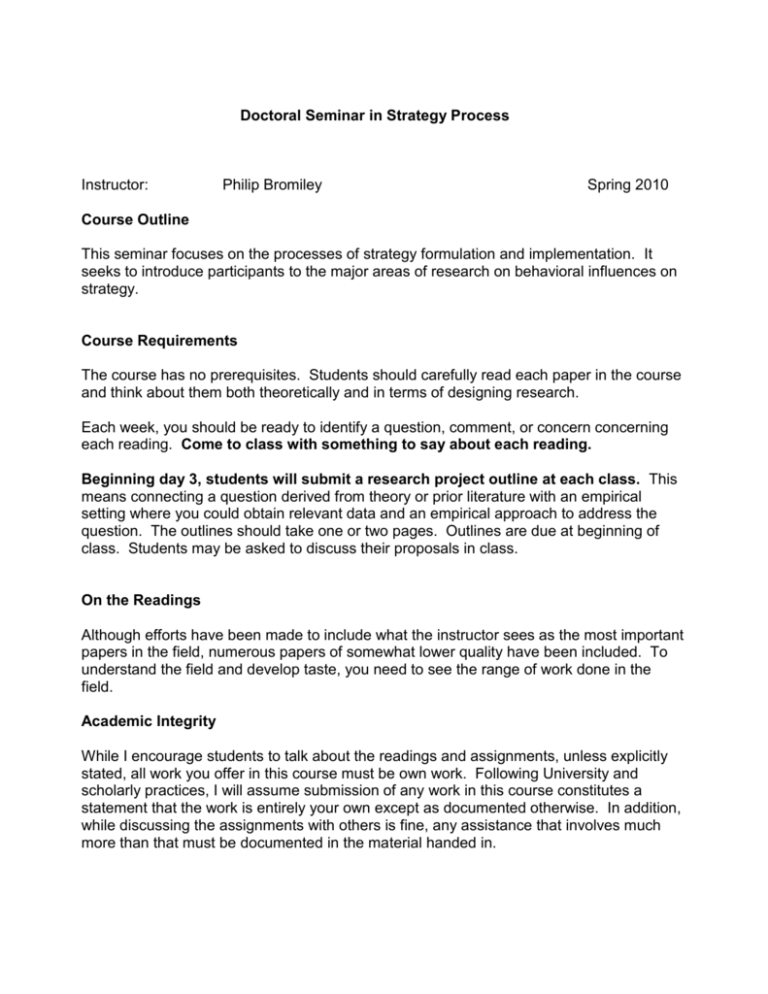Syllabus
advertisement

Doctoral Seminar in Strategy Process Instructor: Philip Bromiley Spring 2010 Course Outline This seminar focuses on the processes of strategy formulation and implementation. It seeks to introduce participants to the major areas of research on behavioral influences on strategy. Course Requirements The course has no prerequisites. Students should carefully read each paper in the course and think about them both theoretically and in terms of designing research. Each week, you should be ready to identify a question, comment, or concern concerning each reading. Come to class with something to say about each reading. Beginning day 3, students will submit a research project outline at each class. This means connecting a question derived from theory or prior literature with an empirical setting where you could obtain relevant data and an empirical approach to address the question. The outlines should take one or two pages. Outlines are due at beginning of class. Students may be asked to discuss their proposals in class. On the Readings Although efforts have been made to include what the instructor sees as the most important papers in the field, numerous papers of somewhat lower quality have been included. To understand the field and develop taste, you need to see the range of work done in the field. Academic Integrity While I encourage students to talk about the readings and assignments, unless explicitly stated, all work you offer in this course must be own work. Following University and scholarly practices, I will assume submission of any work in this course constitutes a statement that the work is entirely your own except as documented otherwise. In addition, while discussing the assignments with others is fine, any assistance that involves much more than that must be documented in the material handed in. Assignments Day 1: Introduction Bromiley, P., Behavioral Foundations for Strategic Management. Hansen, G. S. and Wernerfelt B. 1989. Determinants of Firm Performance: The Relative Importance of Economic and Organizational Factors. Strategic Management Journal. 10: 399-411. Allison, G. T. 1969. Conceptual models and the Cuban missile crisis. The American Political Science Review, 63: 689-718. Day 2: Decisons 1 Barr, P., Stimpert, J. L., and Huff, A. S. 1992. Cognitive Change, Strategic Action, and Organizational Renewal. Strategic Management Journal. 13:15-36. Dutton, J., Ashford, S., O’Neill, R., Lawrence, K.A. 2001. Moves that Matter: Issue Selling and Organizational Change. Academy of Management Journal. 44(4) 716-737. Tripsas, M. and Gavetti, G. 2000. Capabilities, Cognition, and Inertia: Evidence From Digital Imaging. Strategic Management Journal. 21(10-11): 1147-1161. Day 3: Decisions 2 Miller, K. D. and Shapira, Z. 2004. An Empirical Test of Heuristics and Biases Affecting Real Option Valuation. Strategic Management Journal. 25(3): 269-284. Reger, R. K. and Huff, A. S. 1993. Strategy Groups: A Cognitive Perspective. Strategic Management Journal. 14(2) 103-124. McNamara, G., Luce, R.A., and Thompson. 2002. Examining the effect of complexity in cognitive strategic group knowledge structures on firm performance. Strategic Management Journal. 23(2) 153-170. Eisenhardt, K. M. 1989. Making Fast Strategic Decisions in High-Velocity Environments. Academy of Management Journal. 32(3): 543-576. 2 Day 4: Predicting Strategic Change: Risk March, J. G. & Shapira, Z. 1987. Managerial perspectives on risk and risk taking. Management Science, 33: 1404-1418. Bromiley, P. 1991. "Testing a Causal Model of Corporate Risk-taking and Performance," Academy of Management Journal, 34(1), 37-59. Greve, H. R., 1998. Performance, Aspirations, and Risky Organizational Change, Administrative Science Quarterly, 43: 58-86. Day 5: Top Management Teams Michel, J. and Hambrick, D. 1992. Diversification Posture and Top Management Team Characteristics. Academy of Management Journal. 35(1): 9-37. Wiersema, M. and Bantel, K. 1992. Top Management Team Demography and Corporate Strategic Change. Academy of Management Journal. 35(1): 91-121. Carpenter, M. 2002. The Implications of Strategy and Social Context for the Relationship Between Top Management Team Heterogeneity and Firm Performance. Strategic Management Journal. 23(3): 275-284. Day 6: TMT Diversity and Conflict Zajac, E. J. 1990. CEO Selection, Succession, Compensation, and Firm Performance: A Theoretical Integration and Empirical Analysis. Strategic Management Journal. II: 217-230. Zajac, E., & Westphal, J. D., 1996. Who Shall Succeed? How CEO/Board Preferences and Power Affect the Choice of New CEOs. Academy of Management Journal, 39(1) 64-90. Westphal, J. D. 1999. Collaboration in the Boardroom: Behavioral and Performance Consequences of CEO-Board Social Ties, Academy of Management Journal, 42(1) 724. Week 7: CEO’s and Boards 2 Carpenter, M. and Westphal, J. 2001. The Strategic Context of External Network Ties: Examining the Impact of Director Appointments on Board Involvement in Strategic Decision Making. Academy of Management Journal. 44(4): 639 3 Westphal, J. and Fredrickson, J. 2001. Who Directs Strategic Change? Director Experience, the Selection of New CEOs, and Change in Corporate Strategy. Strategic Management Journal. 22(12): 1113-1137. Davis, G. Yoo, M., Baker, W. 2003. The Small World of the American Corporate Elite, 1982-2001. Strategic Organization. 1(3): 301-327. Mintzberg, H. and Waters, J. A. 1982. Tracking Strategy in an Entrepreneurial Firm. Academy of Management Journal. 25(3): 465-499. 4







